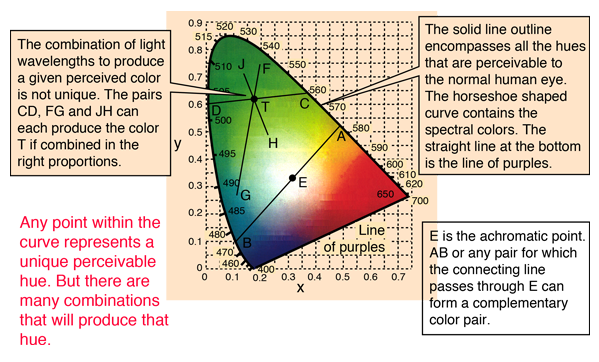Color Perception
The properties of color which are inherently distinguishable by the human eye are hue, saturation, and brightness. While we know that the spectral colors can be one-to-one correlated with light wavelength, the perception of light with multiple wavelengths is more complicated. It is found that many different combinations of light wavelengths can produce the same perception of color. This can be put in perspective with the CIE chromaticity diagram.

The white or achromatic point E can also be achieved with many different mixtures of light, e.g. with complementary colors. If you have two illuminating sources which appear to be equally white, they could be obtained by adding two distinctly different combinations of colors. This implies that if you used them to illuminate a colored object which selectively absorbs certain wavelengths of light, that object might look very different when viewed with the two different "white" lights.
The rainbow spectrum of pure spectral colors falls along the outside curve of the chromaticity diagram. Those colors can be described as fully saturated colors. The "line of purples" across the bottom represents colors that cannot be produced by any single wavelength of light. A point along the line of purples could be considered to represent a fully saturated color, but it requires more than one wavelength of light to produce it.

As another example of the nature of color perception, the results of two different additive mixtures AB and CD are shown, yielding an identical perceived color. This example is shown from the perspective of the 1976 CIE Standard since it more accurately portrays the effective difference in perceived color over the range of the chromaticity diagram.
| Additive color mixing with the CIE system |
Vision concepts
Color vision
Color measurement
Reference
Williamson & Cummins
| HyperPhysics***** Light and Vision | R Nave |

